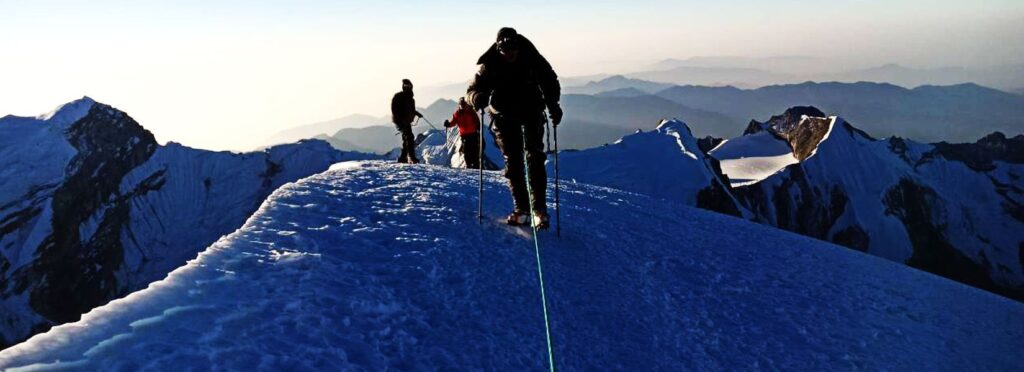Mera Peak, at 6,476 meters/21,247 feet, is the highest trekking peak in the Himalayas. It is a magnificently tall peak. It is an introduction mountain that no beginner climber should pass up. In the Khumbu region, Mera Peak lies adjacent to Everest, the highest mountain in the world. The peak’s breathtaking views of the eight thousand Himalayas from the top have contributed to its enormous rise in popularity. Enjoy expansive views of the world’s five highest mountains, Everest, Kanchenjunga, Makalu, Lhotse, and Cho Oyu, from the summit of Mera Peak. From the summit of this peak, you can also see the amazing vistas of several other gorgeous Himalayas covered in snow.
Mera North (6,476 meters/21,246 feet), Mera Central (6,461 meters/21,197 feet), and Mera South (6,065 meters/19.898 feet) are the three unique peaks of the Mera Peak. But among climbers, Mera North is regarded as the peak’s main face and is the most well-liked. For novice climbers looking to gain some experience and competence for more challenging mountain trips, this peak has grown in popularity. Mera Peak therefore acts as a training ground for more difficult and arduous climbs.
Climbing Mera Peak isn’t the easiest or the toughest thing to do. The breathtaking Mera Peak’s high altitude and semi-technical trails make climbing it a relatively challenging task. The majority of the route is simple and uncomplicated, however there are a few challenging parts. Furthermore, those challenging parts are ideal for inexperienced expeditors to acquire climbing abilities because they are not overly taxing. Basic mountaineering skills and improved preparation can help you get through those sections.
Encounters of the Mera Peak Journey
Mera Peak Trekking is an amazing adventure that is recommended for those who have explored both the Khumbu and Hinku Valleys simultaneously. It’s an amazing trip that combines climbing and trekking. Trekking alone is possible on Mera Peak since it is less crowded than other well-known summits in the Everest region. Reaching the Base Camp requires traveling through the isolated and untraveled areas of Hinku Valley. In addition, you can explore the various high-altitude settings and take in the breathtaking panoramic vistas. This combination of trekking and climbing challenges will put your resolve, ability, and self-assurance to the test with a variety of experiences.
Traveling through the untainted wilderness paths offers you a glimpse into the untainted beauty of the Himalayas. Similar to this, you can have a deeper understanding of the distinctive local culture and way of life of the mountain people by traveling through traditional rural settlements. In Sherpa settlements, you can engage in amicable conversation with the local populations to enhance your hiking experience. A deeper investigation of the several surrounding villages impacted by Buddhist and Tibetan cultures offers a distinctive look at the area’s architectural legacy, customs, and way of life.
The amenities and services along Mera Peak’s trekking trails have been improved in recent years. There are several different lodging choices, including hotels, teahouses, and lodges. The convenience of trekkers and expeditors has increased due to the peak’s rising appeal and the region’s infrastructure development.
Mera Peak is a guiding light for mountaineers seeking adventure. Both experienced climbers and novice mountaineers will find it encouraging. This beginner peak offers easy climbs that are ideal for those who are just starting out in mountaineering and want to get better at climbing. The invaluable experience of reaching a 6,000-meter class peak contributes to the development of climbing expertise and self-assurance. For those who want to experience the excitement of trekking and climbing at high altitudes, Mera Peak is challenging but doable. Devoting ourselves to the ordeal of reaching Mera Peak, we must investigate the obstacles, planning, and benefits of this thrilling expedition.
Understanding the Difficulties of the Journey.
Reaching the summit of Mera Peak is a significant accomplishment. Although Mera Peak is not as difficult technically, it nevertheless presents a unique mix of challenges that should be carefully considered and planned for before ascending. These are a few elements that determine how challenging the Mera Peak expedition is.
High-altitude Weather
The weather in higher altitude locations, such as Mera Peak, is highly variable throughout the year. Similar to how the weather is dynamic and subject to sudden changes, it also varies quickly. There’s a greater chance of severe rain and snowfall due to the current meteorological instability. The off-seasons, such as the winter and monsoon, have significantly worse weather. As a result, depending on the season and shifting heights, the weather and climate in the alpine regions fluctuate greatly.
Off-season Challenges
The monsoon, or wet summer, is when snowfall and snowstorms are most common in alpine regions. In the lower regions, there are also regular, intense downpours. The temperature lowers dramatically in the winter, and the trekking track is covered in enormous mounds of thick snow. In addition, the journey becomes difficult due to the accumulation of snow on the steep sections of the climb and small crossings. Above the Mera Peak Base Camp, temperatures can plummet to an average of -10 degrees Celsius with severe snow cold. Therefore, it is not recommended to attempt the trekking and climbing expedition of Mera Peak under such hazardous weather circumstances.
Altitude Challenges
Situated amidst the magnificent Himalayas, Mera Peak soars to a remarkable height of more than 6,000 meters. Climbers who engage in it run the risk of experiencing adverse weather, low oxygen levels, and altitude sickness, also known as acute mountain sickness (AMS). Lukla is the starting point of the daring trip to the top of the highest trekking peak in the Himalayas. With every step you take toward the summit, you will ascend from your starting elevation of 2,860 meters. Zatrawal Pass, at 4,600 meters/15,092 feet, is one of the highest Himalayan passes that must be crossed on the Mera Peak trip.
You will need to spend four to six days above 5,000 meters in elevation in order to reach the 6,476-meter peak of Mera Peak. During these days, you will be getting used to the altitude and getting ready for the push to the summit at 5,800 meters’ Mera Peak High Camp and Base Camp, respectively. As a result, Mera Peak has a chance of experiencing altitude sickness after reaching elevations above 2,500 meters.
Technical Climbing Sections
Mera Peak Climbing is categorized as an excursion of moderate difficulty, with an Alpine Grade PD rating. There are some challenging ice, snow, and glacier climbing parts. Mera Peak is semi-technical and requires a basic level of mountaineering knowledge and skills. It is important to utilize basic climbing equipment such as harnesses, fixed ropes, ice axes, crampons, and so forth.
You have to climb through the glacial moraines and negotiate the crevasses. Similar to this, going through ice areas, rocky, steep slopes, and rough spots is necessary, particularly in the last stages of climbing to the summit.
Duration and Physical Endurance
The goal of Mera mountain, a high-altitude trekking and climbing experience, is to reach the summit of the Himalayan region’s highest trekking mountain. You must walk between 100 and 120 kilometers to reach the summit of Mera Peak. In addition, the paths are not easy to navigate, and the journey presents more difficulties if you are not accustomed to walking for extended periods of time. To adjust to increasing elevations, you must take the appropriate amounts of time to acclimate. Although gradual acclimatization eventually results in longer durations, it is necessary for safer and simpler climbs.
Trekking to Mera Peak takes place over several days on secluded, rugged terrain. The route passes across harsh, difficult mountainous terrain with multiple sharp ascents and descents. Significant endurance capacity is needed because to the harsh high-altitude topographies and prolonged exertion required for the successive hiking days. For the successful Mera Peak expedition, mental toughness and perseverance are just as important as physical strength and endurance.
Training and Preparations to Deal With Difficulties.
In order to enhance the likelihood of a successful summit bid and guarantee a secure ascent, it is crucial to engage in preparatory training and preparation. Here are some tips for getting ready for the hike and expedition to Mera Peak.
Physical Fitness
Exercises that increase strength, endurance, and stamina should be prioritized in addition to cardiovascular activities. Think about doing exercises like push-ups, squats, deadlifts, cycling, swimming, etc. Exercises and strength training prime the body for an exciting and demanding trip across the high altitudes of the Himalayas.
Effective Acclimatization
The air gets thinner as we continue to rise to greater elevations. To help the body acclimate to the lower oxygen level and adapt to the changing elevation, a slow ascent with adequate acclimatization is essential. In the end, it lessens the possibility of altitude sickness. Rest enough and let yourself a few days to gradually adjust to the new altitude.
Basic Mountaineering Skills
Mera Peak is appropriate for beginners with only rudimentary climbing knowledge and abilities. You should be proficient in the use of various climbing tools, such as ropes, crampons, and ice axes. If you lack these abilities, you can still obtain invaluable advice, instructions, and knowledge by enrolling in pre-climbing training programs or employing knowledgeable guides on the trip.
Rewards of Successful Mera Peak Journey
Trekking through unspoiled, breathtaking landscapes of enchanted forests and charming medieval towns is full of moments of pure majesty and awe. The Mera Peak trip is made much more rewarding by getting to know the locals and their genuine hospitality.
Reaching the summit of Mera Peak successfully is an incredibly satisfying experience that leaves you feeling accomplished. A closer connection to nature and the grandeur of the mountains may be had from the summit of Mera Peak, which offers panoramic views of the towering Himalayan peaks. You’ll be treated to a breathtaking view of the Himalayas that will stay with you forever.
The gratifying endeavor of meticulous planning and preparation, along with dedication and a resolve to conquer, fully offsets Mera Peak Climbing challenges. Although the road can be difficult at times, the experiences gained and the memories made along the route are truly amazing. need you have the audacity to envision yourself scaling new heights in the Himalayas, you need be ready to face and overcome any obstacles that may arise.
Packing Considerations for Mera Peak
Weather Consideration:
It’s important to prioritize layering clothes while preparing for Mera Peak because of the temperature swings at higher elevations. It is advisable to wear layers that are simple to put on or take off in order to control body temperature. Similarly, you must pack, taking into account the low temperatures, possible snowfall, and blizzards at higher altitudes. To get ready for the Mera Peak trek, you can check the weather prediction in advance.
Clothing selection:
To stay dry during the trip, think about bringing clothing composed of materials that wick away moisture. Breathable clothing also offers comfort on arduous hikes. For the Mera Peak expedition, you can also take layers of base, mid, and outer apparel. The purpose of base layers is insulation; middle layers give warmth; and outer layers offer wind and precipitation protection. Remember to pack rain gear in case of unpredictable downpours.
Navigation Safety:
Learn routes with the aid of maps, GPS units, or travel guides. For navigational purposes and to keep track of direction, you can carry a compass. For treks in the early morning or late at night, bring headlamps with extra batteries. Keep a satellite phone on you as well for communication in far-off places.
Hygiene and Comfort:
Carry UV-blocking sunglasses to protect your eyes from the glare of the sun and snow. For extra protection from the sun, you might put on a hat with a wide brim. By using high-SPF sunscreen, you can avoid being sunburned. To prevent cracked lips, use lip balm, and think about bringing personal hygiene items.
Hydration and Nutrition:
Carrying adequate water with you will help you stay hydrated during the trek. The purifying tablets and drops will guarantee that the water you consume is safe to drink. When traveling for extended periods of time, think about bringing high-energy snacks like energy bars, almonds, and dried fruits. These will help your body stay energized. Stress wholesome meals and a well-balanced diet to prevent health problems and illness vulnerability.







